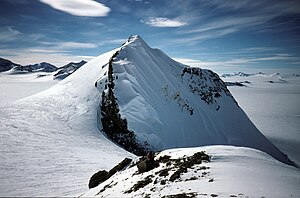Difference between revisions of "Mount Jackson"
m |
m |
||
| Line 4: | Line 4: | ||
|picture=Mount Jackson, Antarctica.jpg | |picture=Mount Jackson, Antarctica.jpg | ||
|picture caption=South-east of Mount Jackson ridge | |picture caption=South-east of Mount Jackson ridge | ||
| − | |latitude= | + | |latitude=-71.3833 |
| − | |longitude= | + | |longitude=-63.3667 |
|height=10,007 feet | |height=10,007 feet | ||
}} | }} | ||
| Line 16: | Line 16: | ||
The mountain was named by the United States Antarctic Service for Andrew Jackson, the seventh President of the United States, who signed the bill authorizing the United States Exploring Expedition, 1838–42, led by Lt. Charles Wilkes of the US Navy. Alternate names for the mountain include ''Mount Andrew Jackson'' and ''Mount Ernest Gruening''. | The mountain was named by the United States Antarctic Service for Andrew Jackson, the seventh President of the United States, who signed the bill authorizing the United States Exploring Expedition, 1838–42, led by Lt. Charles Wilkes of the US Navy. Alternate names for the mountain include ''Mount Andrew Jackson'' and ''Mount Ernest Gruening''. | ||
| + | |||
==First ascent== | ==First ascent== | ||
The first ascent of Mount Jackson was achieved by a team from the British Antarctic Survey: J C Cunningham (Leader), J L Gardner, (General Assistant) B Pimm Smith (Meteorologist) and D T Todd (General Assistant) reached the summit on 23 November 1964.<ref>(1965) British activities in the Antarctic, 1963–64. Polar Record, 12 , pp 416-422 doi:10.1017/S0032247400054930</ref> | The first ascent of Mount Jackson was achieved by a team from the British Antarctic Survey: J C Cunningham (Leader), J L Gardner, (General Assistant) B Pimm Smith (Meteorologist) and D T Todd (General Assistant) reached the summit on 23 November 1964.<ref>(1965) British activities in the Antarctic, 1963–64. Polar Record, 12 , pp 416-422 doi:10.1017/S0032247400054930</ref> | ||
| Line 21: | Line 22: | ||
==References== | ==References== | ||
{{reflist}} | {{reflist}} | ||
| − | *{{ | + | *{{BATgaz}} |
{{DEFAULTSORT:Jackson, Mount}} | {{DEFAULTSORT:Jackson, Mount}} | ||
[[Category:Territory tops]] | [[Category:Territory tops]] | ||
Revision as of 11:22, 1 August 2014
| Mount Jackson | |
| British Antarctic Territory | |
|---|---|
 South-east of Mount Jackson ridge | |
| Summit: | 10,007 feet 71°22’60"S, 63°22’0"W |
Mount Jackson is a massive mountain that dominates the upland in the southern part of the Antarctic Peninsula. It rises to a majestic summit peak 10,007 feet above sea level on south and east, while the north flank is occupied by a vast cirque. It stands on the continent of Antarctica within the British Antarctic Territory. It is the highest mountain in the territory and indeed its summit is the highest point amongst all British territories.
With a prominence of 7,2175 feet above the surrounding land, in worldwide terms, Mount Jackson is listed as an "Ultra prominent peak".
Discovery and name
Mount Jackson was discovered by members of the United States Antarctic Service, 1939–41, in aerial flights and sighted by the ground survey party on the plateau.
The mountain was named by the United States Antarctic Service for Andrew Jackson, the seventh President of the United States, who signed the bill authorizing the United States Exploring Expedition, 1838–42, led by Lt. Charles Wilkes of the US Navy. Alternate names for the mountain include Mount Andrew Jackson and Mount Ernest Gruening.
First ascent
The first ascent of Mount Jackson was achieved by a team from the British Antarctic Survey: J C Cunningham (Leader), J L Gardner, (General Assistant) B Pimm Smith (Meteorologist) and D T Todd (General Assistant) reached the summit on 23 November 1964.[1]
References
- ↑ (1965) British activities in the Antarctic, 1963–64. Polar Record, 12 , pp 416-422 doi:10.1017/S0032247400054930
Warning: Default sort key "Jackson, Mount" overrides earlier default sort key "Jackson".